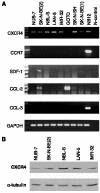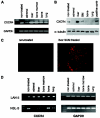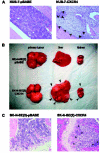Tissue microenvironment modulates CXCR4 expression and tumor metastasis in neuroblastoma
- PMID: 17325742
- PMCID: PMC1803034
- DOI: 10.1593/neo.06670
Tissue microenvironment modulates CXCR4 expression and tumor metastasis in neuroblastoma
Abstract
Neuroblastoma (NB) is derived from intrinsic migratory neural crest cells and has a high potential for distant metastasis. Growing evidence has implicated chemokine receptors, especially CXCR4, which normally control immune and inflammatory cell migration, as having important roles in tumor progression. In this study, we investigated the expression of CXCR4 in eight different NB cell lines and found that CXCR4 expression is dynamically regulated in NB and can be modulated by different tissue stromata. In addition, we demonstrate that IL-5 and IFN-gamma are released from stromal cells and act as differential mediators for CXCR4 expression. We also overexpressed CXCR4 in two NB cell lines, NUB-7 and SK-N-BE(2), and studied the role of CXCR4 in NB metastasis both in vitro and in vivo. In vitro transwell invasion assay showed that CXCR4 overexpression promoted NB cell migration preferentially toward a bone marrow stromal cell-conditioned medium. Using an in vivo xenograft model, CXCR4-overexpressing cells showed an increased incidence of metastasis, most notably bone marrow metastasis. Our studies reveal critical roles for CXCR4 in NB metastasis and provide insights into the regulatory mechanism of chemokine receptors in NB and the importance of the tissue microenvironment in modulating tumor cell behavior.
Figures





Similar articles
-
The chemokine receptor CXCR4 strongly promotes neuroblastoma primary tumour and metastatic growth, but not invasion.PLoS One. 2007 Oct 10;2(10):e1016. doi: 10.1371/journal.pone.0001016. PLoS One. 2007. PMID: 17925864 Free PMC article.
-
The CXCR4/CXCR7/CXCL12 Axis Is Involved in a Secondary but Complex Control of Neuroblastoma Metastatic Cell Homing.PLoS One. 2015 May 8;10(5):e0125616. doi: 10.1371/journal.pone.0125616. eCollection 2015. PLoS One. 2015. PMID: 25955316 Free PMC article.
-
Characterization of neuroblastoma bone invasion/metastasis in established bone metastatic model of SY5Y and KCNR cell lines.Childs Nerv Syst. 2013 Jul;29(7):1097-105. doi: 10.1007/s00381-013-2086-8. Epub 2013 Apr 5. Childs Nerv Syst. 2013. PMID: 23559392
-
The Extracellular Matrix and Neuroblastoma Cell Communication-A Complex Interplay and Its Therapeutic Implications.Cells. 2022 Oct 10;11(19):3172. doi: 10.3390/cells11193172. Cells. 2022. PMID: 36231134 Free PMC article. Review.
-
Targeting the Tumor Microenvironment in Neuroblastoma: Recent Advances and Future Directions.Cancers (Basel). 2020 Jul 25;12(8):2057. doi: 10.3390/cancers12082057. Cancers (Basel). 2020. PMID: 32722460 Free PMC article. Review.
Cited by
-
The chemokine receptor CXCR4 strongly promotes neuroblastoma primary tumour and metastatic growth, but not invasion.PLoS One. 2007 Oct 10;2(10):e1016. doi: 10.1371/journal.pone.0001016. PLoS One. 2007. PMID: 17925864 Free PMC article.
-
Subcellular distribution and expression of prenylated Rab acceptor 1 domain family, member 2 (PRAF2) in malignant glioma: Influence on cell survival and migration.Cancer Sci. 2010 Jul;101(7):1624-31. doi: 10.1111/j.1349-7006.2010.01570.x. Epub 2010 Mar 19. Cancer Sci. 2010. PMID: 20412121 Free PMC article.
-
Triptolide Inhibits Proliferation and Migration of Human Neuroblastoma SH-SY5Y Cells by Upregulating MicroRNA-181a.Oncol Res. 2018 Sep 14;26(8):1235-1243. doi: 10.3727/096504018X15179661552702. Epub 2018 Feb 9. Oncol Res. 2018. Retraction in: Oncol Res. 2025 May 29;33(6):1507. doi: 10.32604/or.2024.056917. PMID: 29426375 Free PMC article. Retracted.
-
PGK1 as predictor of CXCR4 expression, bone marrow metastases and survival in neuroblastoma.PLoS One. 2013 Dec 20;8(12):e83701. doi: 10.1371/journal.pone.0083701. eCollection 2013. PLoS One. 2013. PMID: 24376734 Free PMC article.
-
CXCR4 antagonists suppress small cell lung cancer progression.Oncotarget. 2016 Dec 20;7(51):85185-85195. doi: 10.18632/oncotarget.13238. Oncotarget. 2016. PMID: 27835905 Free PMC article.
References
-
- Charo IF, Ransohoff RM. The many roles of chemokines and chemokine receptors in inflammation. N Engl J Med. 2006;354:610–621. - PubMed
-
- Laudanna C, Alon R. Right on the spot. Chemokine triggering of integrin-mediated arrest of rolling leukocytes. Thromb Haemost. 2006;95:5–11. - PubMed
-
- Bajetto A, Bonavia R, Barbero S, Florio T, Schettini G. Chemokines and their receptors in the central nervous system. Front Neuroendocrinol. 2001;22:147–184. - PubMed
-
- Balkwill F, Mantovani A. Inflammation and cancer: back to Virchow? Lancet. 2001;357:539–545. - PubMed
-
- Vicari AP, Caux C. Chemokines in cancer. Cytokine Growth Factor Rev. 2002;13:143–154. - PubMed
Publication types
MeSH terms
Substances
LinkOut - more resources
Full Text Sources
Other Literature Sources
Medical
Research Materials
